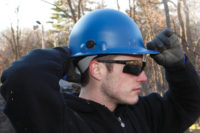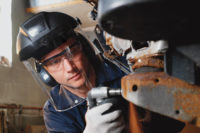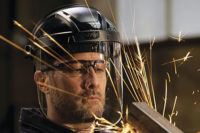Beginning with site construction through decommissioning, protecting the individual’s head and face should be a primary safety consideration during every phase of a project. In the drilling category alone, injuries to the head or eyes typically comprise more than 14 percent of recordable incidents, according to the International Association of Drilling Contractors (IADC). Furthermore, OSHA ranked incorrect use of personal protective equipment as fourth among most commonly cited violations in oil and gas well drilling and servicing in 2005. The cost of an injury to a worker’s head or face can be substantial.
Among upstream activities such as finding, drilling, flaring and producing, incidents occur in many places and to all crew members. Many types of equipment and operations are involved and all parts of the body are at risk. For these reasons, hard hats are worn in nearly every upstream application to protect workers from head injuries ranging from minor bumps to concussions and even severe trauma which can result in death.
Consider comfort, fit & chemical exposure
When it comes to selecting a cap, performance should be the number one consideration. OSHA and the Canadian Standards Association (CSA) have standards in place to help ensure workers are properly protected. Each organization’s standard specifies two levels of protection. Hard hats labeled ANSI Type I/CSA Type 1 are intended to protect the wearer against impact to and penetration of the crown, or top, only, while ANSI Type II/CSA Type 2 hats protect against both lateral and crown impact. The added level of protection that Type II/Type 2 hats provide can be lifesaving. Caps made of high density polyethylene (HDPE) deliver excellent chemical resistance and are ideal for oil and gas applications, while polycarbonate hats, which deliver the lowest level of chemical protection, should be avoided.
Next to protection, wearer comfort is the second most important feature of a hard hat. Studies prove that uncomfortable caps are not worn consistently, leaving workers vulnerable to injury. Be sure to outfit workers with a cap that goes on — and stays on — comfortably. Such a fit can be achieved by taking into account the number of suspension points (the more points, the greater the comfort and fit), the type of suspension material and headband options. To ensure a safe fit, hats must be worn as snugly as possible, so sizing and adjustability options are important considerations as well.
Finally, because of abundant chemical exposure in upstream environments, workers should be encouraged to conduct a thorough inspection of their hard hat and suspension before each use. Even chemicals found in paint, sunscreen and insect repellant can interfere with cap and suspension integrity. Other conditions that affect the hat’s lifespan include ultraviolet exposure, temperature extremes and daily wear. If the hat shows evidence of cracking, flaking, gouging or degradation, replace it immediately. Likewise, if the suspension exhibits signs of fraying or cracking, replace it immediately. Otherwise, a good rule of thumb is to replace the suspension every year and the shell every five years.
Activities such as those conducted downstream in refineries and petrochemical plants pose various hazards to the head and face as well. Here, liquid contaminants are more abundant and therefore face protection worn in tandem with hard hats and other PPE is common. When selecting face shields, look for differentiated chemical-resistant materials that specifically meet the protective requirements for the hazards. To prolong clear visibility and visor life, look for visors with anti-fog and anti-scratch coatings. And remember, a primary form of protective eyewear or goggles must be worn in conjunction with any secondary form of protection such as a face shield or welding helmet.
When any combination of eyewear, hard hat, face shield, hearing protection and the like are used in tandem, be sure to check their compatibility. Together, head and face protection should provide a comfortable, secure and reliable fit. Convenience features that allow the user to quickly and easily switch between types of face protection save time, while easy adjustability features eliminate worker frustration and help ensure that PPE stays on — even while making adjustments. Much like hard hats, if a face shield comes in contact with a chemical, replace the visor.
An invaluable investment
Those who work in oil and gas are subject to a multitude of hazards, and proper head and face protection is generally recognized as a worthwhile investment in every phase of a project. But there’s room for improvement when it comes to compliance. By selecting hard hats and face shields that deliver maximum protection, are constructed of durable, high-quality materials suitable for the specific hazards, and feature optimal comfort and fit options, workers benefit from a safer working environment and employers benefit from a more productive workforce.



